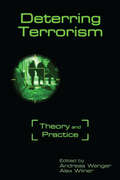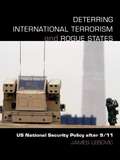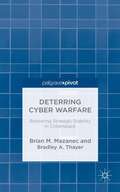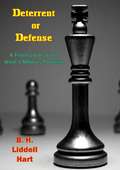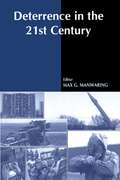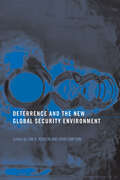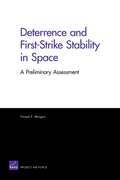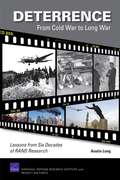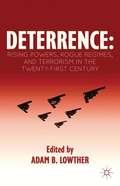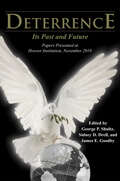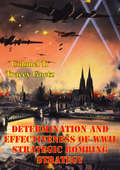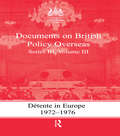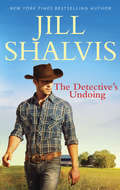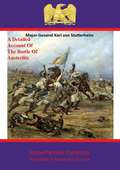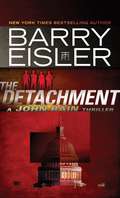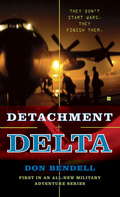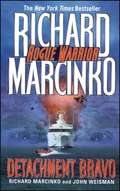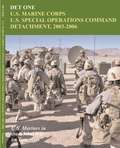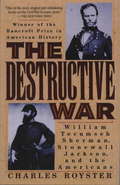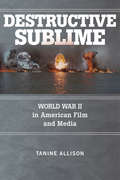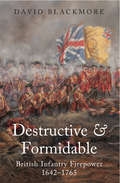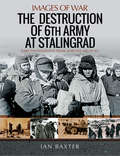- Table View
- List View
Deterring Terrorism: Theory and Practice
by Andreas Wenger Alex WilnerDuring the Cold War, deterrence theory was the cornerstone of U. S. foreign policy. Following the 9/11 terrorist attacks, however, popular wisdom dictated that terrorist organizations and radical fanatics could not be deterred-and governments shifted their attention to combating terrorism rather than deterring it. This book challenges that prevailing assumption and offers insight as to when and where terrorism can be deterred. It first identifies how and where theories of deterrence apply to counterterrorism, highlighting how traditional and less-traditional notions of deterrence can be applied to evolving terrorist threats. It then applies these theoretical propositions to real-world threats to establish the role deterrence has within a dynamic counterterrorism strategy-and to identify how metrics can be created for measuring the success of terrorism deterrence strategies. In sum, it provides a foundation for developing effective counterterrorism policies to help states contain or curtail the terrorism challenges they face.
Deterring International Terrorism and Rogue States: US National Security Policy after 9/11 (Contemporary Security Studies)
by James H. LebovicThis new study challenges the widely held view that many current US adversaries cannot be deterred, maintaining that deterrence is not a relic of the Cold War period and that it should shape US policies toward so-called ‘rogue states’ and terror groups. James Lebovic argues that deterrence principles continue to apply, and focuses upon the ‘three pillars’ of the Bush administration’s national security policy: missile defence, which preoccupied the administration until September 11, 2001 pre-emption, which became the US focus with the September 11 attacks and US success in overthrowing the Taliban regime in Afghanistan homeland security, which the administration has portrayed as more a natural response to threat than an aspect of policy that must be reconciled with the other pillars. Deterring International Terrorism and Rogue States asserts that bad offences and defences have been endemic to the current US policy approach, leading US policy makers to pursue policies that require them to do everything without adequate concern for resource trade-offs, overreach, and unintended consequences. This book will be of great interest to students of US foreign policy, national and international security, terrorism and international relations in general.
Deterring Cyber Warfare: Bolstering Strategic Stability in Cyberspace
by Brian M. Mazanec Bradley A. ThayerWhile the deterrence of cyber attacks is one of the most important issues facing the United States and other nations, the application of deterrence theory to the cyber realm is problematic. This study introduces cyber warfare and reviews the challenges associated with deterring cyber attacks, offering key recommendations to aid the deterrence of major cyber attacks.
Deterrent or Defense: A Fresh Look at the West’s Military Position
by B. H. Liddell HartHere is a much-needed assessment and summing-up on four current strategic situation by B. H. Liddell Hart, the leading military analyst of our time. Taking a clear, hard look at Western defense capabilities and strategic planning, particularly as they are embodied in NATO, he has come up with suggestions for radical but vital revisions in our defense policies.Fifteen years have elapsed since Captain Liddell Hart forecast the consequences of atom-bomb diplomacy. Now, as the NATO powers move uneasily forward in the 1960’s, he shows how the development of the H-bomb—and, indeed, the multiplication in general of nuclear weapons on both sides—has become on the one hand, increasingly self-inhibiting, and, on the other, increasingly precarious as a protective insurance policy, especially in view of the development of log-range missiles.The natural consequences of the current nuclear parity is nuclear nullity. Thus, the nuclear deterrent, in which the West has put so much trust, is fading except as a deterrent to its own kind of action. But the Western powers have not yet come to grips with the problem of finding an adequate and effective replacement for this “fading deterrent.” As a result, the West now finds itself gravely hampered in any attempt to resist the more subtle forms of aggression and pressure.Having carefully analyzed the ailment, the author offers a hopeful cure, demonstrating how the weakness of the West’s present position can be remedied without an intolerable outlay in strain and cost.
Deterrence in the Twenty-first Century
by Max G. ManwaringThis anthology argues that facing the diverse threats in the 'new world disorder' requires a new look and new approaches. The requirement is to establish that contemporary deterrence demands replacing the old 'nuclear theology' with new policy and strategy to deal with the myriad state, non-state, and trans-national nuclear and non-nuclear menaces that have heretofore been ignored or wished away.
Deterrence and the New Global Security Environment
by John Simpson Ian R. KenyonThis collection of papers rigorously examines the current place of deterrence in international security relations, delivering the best of contemporary thinking. This is a special issue of the leading journal Contemporary Security Policy. It shows how and why nuclear deterrence was the central organizing mechanism for international security relations in the second half of the twentieth century. It has been replaced by a new global security environment in which the central role of deterrence, both nuclear and otherwise, appears to have diminished. The Cold War has been succeeded by a new state of play. This book will be of interest to students of military and naval history and security studies.
Deterrence and First-Strike Stability in Space
by Forrest E. MorganSpace stability appears to be eroding as a growing number of states acquire the ability to degrade or destroy U.S. space assets. The United States needs a coordinated national space deterrence strategy designed to operate on both sides of a potential adversary's cost-benefit decision calculus. Future research will determine the most effective and affordable mix of strategies, policies, and systems for strengthening space deterrence.
Deterrence: Lessons from Six Decades of Rand Deterrence Research
by Austin LongSince its inception six decades ago, the RAND Corporation has been one of the key institutional homes for the study of deterrence. This book examines much of this research for lessons relevant to the current and future strategic environment. It is therefore part intellectual history and part policy recommendation, intended to encourage debate and discussion on how deterrence can best be incorporated into U.S. strategy.
Deterrence
by Adam B. LowtherWith many scholars and analysts questioning the relevance of deterrence as a valid strategic concept, this volume moves beyond Cold War nuclear deterrence to show the many ways in which deterrence is applicable to contemporary security. It examines the possibility of applying deterrence theory and practice to space, to cyberspace, and against non-state actors. It also examines the role of nuclear deterrence in the twenty-first century and reaches surprising conclusions.
Deterrence: Its Past and Future—Papers Presented at Hoover Institution, November 2010
by George P. Shultz Sidney D. Drell James E. GoodbyDrawn from the third in a series of conferences the Hoover Institution at Stanford University on the nuclear legacy of the cold war, this report examines the importance of deterrence, from its critical function in the cold war to its current role. Recognizing that today's international environment is radically different from that which it was during the cold war, the need is pressing to reassess the role of nuclear weapons in deterrence in the world of today and to look ahead to the future.
Determining Core Capabilities in Chemical and Biological Defense Science and Technology
by Development Committee on Determining Core Capabilities in Chemical Biological Defense ResearchThe goal of the U. S. Department of Defense's (DoD's) Chemical and Biological Defense Program (CBDP) is to provide support and world-class capabilities enabling he U. S. Armed Forces to fight and win decisively in chemical, biological, radiological, and nuclear (CBRN) environments. To accomplish this objective, the CBDP must maintain robust science and technology capabilities to support the research, development, testing, and evaluation required for the creation and validation of the products the program supplies. The threat from chemical and biological attack evolves due to the changing nature of conflict and rapid advances in science and technology (S&T), so the core S&T capabilities that must be maintained by the CBDP must also continue to evolve. In order to address the challenges facing the DoD, the Deputy Assistant Secretary of Defense (DASD) for Chemical and Biological Defense (CBD) asked the National Research Council (NRC) to conduct a study to identify the core capabilities in S&T that must be supported by the program. The NRC Committee on Determining Core Capabilities in Chemical and Biological Defense Research and Development examined the capabilities necessary for the chemical and biological defense S&T program in the context of the threat and of the program's stated mission and priorities. Determining Core Capabilities in Chemical and Biological Defense Science and Technology contains the committee's findings and recommendations. It is intended to assist the DASD CBD in determining the best strategy for acquiring, developing, and/or maintaining the needed capabilities.
Determination And Effectiveness Of Wwii Strategic Bombing Strategy
by Colonel T. Tracey GoetzWith the collapse of France in 1940, American (US) and British (UK) leadership became keenly aware that the continued security of their nations required the defeat of the Axis powers, particularly Germany. The Allies chose a strategy utilizing a combination of various military actions, most notably a combined bomber offensive (CBO). The CBO would be carried out through a combination of US daylight precision and UK night area bombing.The purpose of this paper is to show why the Allies chose this strategy and evaluate its success. To accomplish this task, the paper will first describe the events that brought about the conflict and the strategy. Crowl's Questions are used as a framework to analyze the factors that influence strategy development and adoption and will illustrate why Allied leaders chose this path. This is followed by a detailed description of the campaign. The principles of war (mass, objective, offensive, maneuver, surprise, security, simplicity, unity of command, and economy of force) are accepted as proven methods for employing forces in combat and are used to evaluate the CBO's effectiveness The paper closes with a summary of the findings and doctrinal implications.The paper will show the Allies adopted US daylight precision and UK night area bombing based on leadership's belief that it could most effectively reduce Germany's means of war and hasten its earliest possible defeat. The Allies successfully achieved this objective primarily through adherence to the principles of mass, objective, offensive, and maneuver.
Detente in Europe, 1972-1976: Documents on British Policy Overseas, Series III, Volume III (Whitehall Histories)
by G. Bennett K. A. HamiltonDrawing on records of the Foreign and Commonwealth Office, this work focuses on Britain's role in the Mutual and Balanced Force Reductions in Vienna, and British policy towards the Soviet Union and its satellites. British reactions to detente between the superpowers are charted.
The Detective's Undoing
by Jill ShalvisDon't miss the conclusion to New York Times bestselling author Jill Shalvis's classic series, The Heirs to the Triple M!Cade McKnight was a loner. A man who liked his horizons open. Then the private investigator met Delia Scanlon. The sexy spitfire drove Cade to distraction, unleashed his tightly controlled emotions and made him feel alive again. But Cade had been hired to find out whether Delia had a true claim to the ranch, not to sleep with his alluring client. Besides, Delia wants things Cade could never give her--a home, a family. And when he discovers the truth about her heritage, it could destroy both their dreams...
Detainee Abuse During Op TELIC: 'a Few Rotten Apples'?
by Timothy WoodThis book reviews the nature of the alleged abuse committed by the UK military forces, exploring the legal paradigm in which the abuse allegedly occurred; the morality of those accused; and the robustness of the accusation of a 'policy of abuse'.
A Detailed Account Of The Battle Of Austerlitz
by Major-General Karl von Stutterheim Pickle Partners Publishing Major John Pine-CoffinThis ebook is purpose built and is proof-read and re-type set from the original to provide an outstanding experience of reflowing text for an ebook reader. A first-hand account by one of the participants in the epoch shaping battle of Austerlitz, in December 1805. Accounted by many to be Napoleon's finest victory, this account is alleged to contain his own commentaries in the text by Major-General von Stutterheim. Von Stutterheim's text is balanced and free from bias despite being written by a serving member of the Austrian military. Added to the text are the notes of a "French officer", most likely to have been Napoleon himself, who dissects the decisions that he and his opponents took during the battle giving the book an insight into the mind of the world's greatest general.
The Detachment (John Rain Thriller #7)
by Barry EislerWhen legendary black ops veteran Colonel Scott "Hort" Horton tracks Rain down in Tokyo, Rain can't resist the offer: a multi-million dollar payday for the "natural causes" demise of three ultra-high-profile targets who are dangerously close to launching a coup in America. But the opposition on this job is going to be too much for even Rain to pull it off alone. He'll need a detachment of other deniable irregulars: his partner, the former Marine sniper, Dox. Ben Treven, a covert operator with ambivalent motives and conflicted loyalties. And Larison, a man with a hair trigger and a secret he'll kill to protect. From the shadowy backstreets of Tokyo and Vienna, to the deceptive glitz and glamour of Los Angeles and Las Vegas, and finally to a Washington, D. C. in a permanent state of war, these four lone wolf killers will have to survive presidential hit teams, secret CIA prisons, and a national security state as obsessed with guarding its own secrets as it is with invading the privacy of the populace. But first, they'll have to survive each other. The Detachment is what fans of Eisler, "one of the most talented and literary writers in the thriller genre" (Chicago Sun-Times), have been waiting for: the worlds of the award-winning Rain series, and of the bestselling Fault Line and Inside Out, colliding in one explosive thriller as real as today's headlines and as frightening as tomorrow's.
Detachment Delta
by Don BendellThese elite Delta Force heroes are highly trained killing machines. Their leader is Charlie Strongheart, a Lakota warrior. His assignment: enter Iran and eliminate a terrorist threat. But when Strongheart is betrayed by those he thought he could trust, he finds himself alone in the heart of the beast.
Detachment Bravo (Rogue Warrior #10)
by Richard Marcinko John WeismanFrom top-secret diplomatic tunnels beneath London to the high seas off the Azores, the New York Times bestselling SEAL commando of eight explosive thrillers takes on a lethal group of Irish Republican Army terrorists in ROGUE WARRIOR DETACHMENT BRAVO The Rogue Warrior is back in a fast-paced, furious, in-your-face adventure! This time he's on the hunt for a high-tech army that smashed the Good Friday Peace Accord and killed a half dozen American and British CEOs. Launched by two self-financed, new-generation terrorists, this murderous wing of the IRA has an even bigger assault planned -- one that promises to stun the world. Now, along with a special ops team made up of Brits, SEALS, spies, and NSA operatives, Marcinko is determined to stop them, but there are a few unknowns: they don't know the target, they don't know the date, and they don't know where the terror is going down.
Detachment Bravo
by John Weisman Richard MarcinkoFrom top-secret diplomatic tunnels beneath London to the high seas off the Azores, the New York Times bestselling SEAL commando of eight explosive thrillers takes on a lethal group of Irish Republican Army terrorists inROGUE WARRIORDETACHMENT BRAVOThe Rogue Warrior is back in a fast-paced, furious, in-your-face adventure! This time he's on the hunt for a high-tech army that smashed the Good Friday Peace Accord and killed a half dozen American and British CEOs. Launched by two self-financed, new-generation terrorists, this murderous wing of the IRA has an even bigger assault planned -- one that promises to stun the world. Now, along with a special ops team made up of Brits, SEALS, spies, and NSA operatives, Marcinko is determined to stop them, but there are a few unknowns: they don't know the target, they don't know the date, and they don't know where the terror is going down.
DET ONE: U.S. Marines in the Global War on Terrorism [Illustrated Edition]
by Lieutenant Colonel John P. PiedmontIllustrated with over 30 photos.The story of the Marine Corps U.S. Special Operations Command Detachment, which became known as Det One, is an extraordinary tale. On its face, the story would not rate a minute’s glance. One small group of Marines, about a hundred in number, formed, trained, and went to war. This all happened as the nation was 18 months into the Global War on Terrorism and as the Marine Corps was deploying I Marine Expeditionary Force in Operation Iraqi Freedom. Yet the story behind the basic facts is not only far more intricate and fascinating, with dramatic episodes and intrepid characters from the Pentagon to Camp Pendleton, it portended great significance for the Marine Corps.What makes the Det One story extraordinary is the shift in Marine Corps policy that brought it about, the maturation of the special operations capabilities of forward-deployed Marine expeditionary units that made it possible, and the patriotism, valor, fidelity, and abilities of the Marines and Navy Corpsmen who manned it. Although Det One has passed now into the history books, its legacy survives in the formation of Marine Corps Special Operations Command and in the lessons learned and experiences of its members, who now continue to serve in dozens of units.
The Destructive War: William Tecumseh Sherman, Stonewall Jackson, and the Americans
by Charles RoysterFrom the moment the Civil War began, partisans on both sides were calling not just for victory but for extermination. And both sides found leaders who would oblige. In this vivid and fearfully persuasive book, Charles Royster looks at William Tecumseh Sherman and Stonewall Jackson, the men who came to embody the apocalyptic passions of North and South, and re-creates their characters, their strategies, and the feelings they inspired in their countrymen. At once an incisive dual biography, hypnotically engrossing military history, and a cautionary examination of the American penchant for patriotic bloodshed, The Destructive War is a work of enormous power.From the Trade Paperback edition.
Destructive Sublime: World War II in American Film and Media (War Culture)
by Tanine AllisonThe American popular imagination has long portrayed World War II as the “good war,” fought by the “greatest generation” for the sake of freedom and democracy. Yet, combat films and other war media complicate this conventional view by indulging in explosive displays of spectacular violence. Combat sequences, Tanine Allison argues, construct a counter-narrative of World War II by reminding viewers of the war’s harsh brutality.Destructive Sublime traces a new aesthetic history of the World War II combat genre by looking back at it through the lens of contemporary video games like Call of Duty. Allison locates some of video games’ glorification of violence, disruptive audiovisual style, and bodily sensation in even the most canonical and seemingly conservative films of the genre. In a series of case studies spanning more than seventy years—from wartime documentaries like The Battle of San Pietro to fictional reenactments like The Longest Day and Saving Private Ryan to combat video games like Medal of Honor—this book reveals how the genre’s aesthetic forms reflect (and influence) how American culture conceives of war, nation, and representation itself.
Destructive & Formidable: British Infantry Firepower, 1642–1756
by David Blackmore&“Looks at British infantry doctrine . . . from the British Civil Wars of the seventeenth century up to just before the American War of Independence.&” —British Civil Wars Blog In the seventeenth and eighteenth centuries, the British Army&’s victories over the French at battles such as Blenheim in 1704, Minden and Quebec in 1759, and over the Jacobites at Culloden in 1746, were largely credited to its infantry&’s particularly effective and deadly firepower. For the first time, David Blackmore has gone back to original drill manuals and other contemporary sources to discover the reasons behind this. This book employs an approach that starts by considering the procedures and practices of soldiers in a given period and analyzes those in order to understand how things were done and, in turn, why events unfolded as they did. In doing so, Blackmore has discovered a specifically British set of tactics, which created this effectiveness and allowed it to be maintained over such a long period, correcting many of the misconceptions about British infantry firepower in the age of the musket and linear warfare in a major new contribution to our understanding of an important period of British military history. &“Essential reading for anyone interested in the British army of the 17th and 18th centuries.&”—Military History Monthly
The Destruction of 6th Army at Stalingrad (Images of War)
by Ian BaxterA pictorial history of the last months of Nazi Germany’s 6th Army at the Battle of Stalingrad during World War II.The scale of death and destruction during the Battle of Stalingrad during late 1942 and early 1943 remains unprecedented in the history of warfare.The annihilation of General von Paulus’s 6th Army epitomized the devastating defeat of Hitler’s ambition to conquer Stalin’s Soviet Union. After the successful Operation Blue offensive, the 6th Army reached the River Volga north of Stalingrad in summer 1942. With overextended supply lines and facing steely opposition, increasingly desperate attempts to seize the city repeatedly failed. Slowly 6th Army became encircled. The German High Command attempted several relief attempts, notably Field Marshal von Manstein’s “Winter Storm,” but all were defeated by the tenacity of the enemy and the Russian winter. To their credit, the men of the 6th Army fought to the end, but by February 1943, the last pockets of German resistance were either destroyed or had surrendered.Thanks to a superb collection of unpublished photographs, this entry in the Images of War series provides an absorbing insight into the dramatic events of the last months of the 6th Army’s doomed existence.
